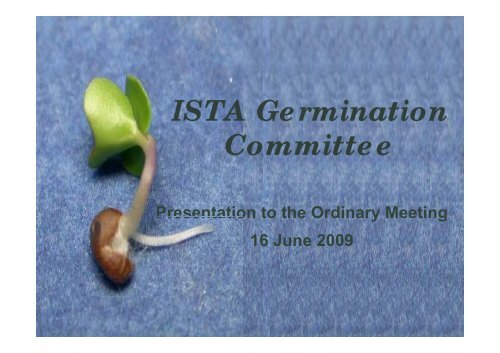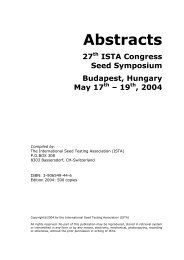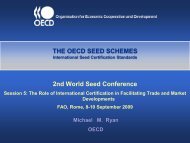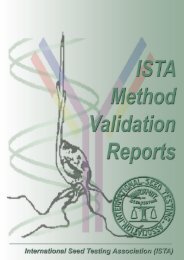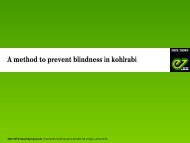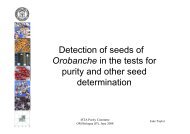Report from the Germination Committee - International Seed Testing ...
Report from the Germination Committee - International Seed Testing ...
Report from the Germination Committee - International Seed Testing ...
Create successful ePaper yourself
Turn your PDF publications into a flip-book with our unique Google optimized e-Paper software.
ISTA <strong>Germination</strong><br />
<strong>Committee</strong><br />
Presentation to <strong>the</strong> Ordinary Meeting<br />
16 June 2009<br />
SASA © Crown Copyright
<strong>Germination</strong> <strong>Committee</strong> Presentation<br />
1. Welcome and Introduction<br />
2. Summary of <strong>the</strong> work of <strong>the</strong> committee over<br />
<strong>the</strong> last year<br />
3. Programme of work for <strong>the</strong> next year<br />
4. Questions <strong>from</strong> <strong>the</strong> audience<br />
Date Country Query Reply<br />
14/03/08 USA <strong>Germination</strong> methods and 14/03/08<br />
information regarding<br />
Jatropha curcus of <strong>the</strong><br />
Euphorbiaceae family<br />
04/03/08 Japan <strong>Testing</strong> seed with a film 05/03/08<br />
coating<br />
26/02/08 Brazil Application of tolerances 27/02/08<br />
when testing fewer than 400<br />
seeds<br />
22/02/08 Cyprus Specifications for a wet Acknowledged<br />
germination cabinet<br />
22/02/08<br />
22/02/08 UK Procedures for ISTA<br />
22/02/08<br />
membership and laboratory<br />
accreditation<br />
04/02/08 Ne<strong>the</strong>rlands Guidelines for assessing 05/02/08<br />
Lolium<br />
28/01/08 Brazil Evaluation of Medicago 28/01/08<br />
sativum seedlings<br />
16/01/08 USA Peer validation procedure for 16/01/08<br />
introducing new germination<br />
methods into <strong>the</strong> ISTA Rules<br />
15/01/08 Iran <strong>Germination</strong> and dormancy 16/01/08<br />
breaking procedure of<br />
Lathyrus rotundifolius<br />
04/01/08 Ne<strong>the</strong>rlands Root to shoot length<br />
16/01/08<br />
requirements for normal<br />
seedlings of Brassicas<br />
20/12/07 Argentina Request to include<br />
16/01/07<br />
germination method for<br />
Brachiaria brizantha in ISTA<br />
Rules<br />
11/12/07 India Can low temperatures 18/06/07<br />
induce albino seedlings in<br />
Zea mays<br />
05/12/07 Canada Evaluation of Lolium seedlings 07/12/07<br />
29/11/07 Argentina Acceptable levels of primary 29/11/07<br />
leaf defects in <strong>Seed</strong>ling<br />
Group A-1-2-3-1
<strong>Committee</strong> Membership<br />
Chair: 1 Ronald Don United Kingdom<br />
Vice-chair: 2 Sylvie Ducournau France<br />
Members: 3 Ignacio Aranciaga Argentina<br />
4 Kari Fiedler United States<br />
5 Krystyna Kolasinska Poland<br />
6 Joël Léchappé France<br />
7 Lea Mazor Israel<br />
8 Gillian McLaren United Kingdom<br />
9 Günter Müller Germany<br />
10 Enrico Noli Italy<br />
11 Takayuki Okuda Japan<br />
12 Anny van Pijlen Ne<strong>the</strong>rlands<br />
13 Zdenka Procházková Czech Republic<br />
14 Hakon Tangeras Norway<br />
15 Gre<strong>the</strong> Tarp Denmark
Validation Studies and Rule Changes<br />
Completed Work<br />
Crepe paper/sand method for beans, cotton, maize and<br />
sunflower.<br />
The use of Organic Growing Media for Vicia faba germination<br />
tests<br />
BP method for Brassica and Sinapis<br />
<strong>Germination</strong> method for Brachiaria brizantha
Validation Studies and Rule Changes<br />
Work in Progress<br />
Dormancy breaking procedures for Eruca sativa<br />
<strong>Germination</strong> method for Solanum nigrum<br />
<strong>Germination</strong> methods for o<strong>the</strong>r tropical species, eg Herbage<br />
species and Jatropha curcas<br />
Rules for testing <strong>Seed</strong> Mixtures<br />
Reduction in <strong>the</strong> time for final germination counts in temperate<br />
grasses<br />
Proposals for major revisions in <strong>Germination</strong> Chapter of <strong>the</strong><br />
Proposals for major revisions in <strong>Germination</strong> Chapter of <strong>the</strong><br />
ISTA Rules
Completed Validation Studies
Use of Crepe Paper covered with Sand<br />
as a germination media for Glycine max,<br />
Helianthus annuus , Phaseolus vulgaris<br />
Zea mays<br />
Last year Top crepe Paper Sand (TPS) was introduced d as<br />
an approved media for <strong>the</strong> germination of Pisum sativum<br />
following a multi-laboratory validation study.<br />
A peer validation study has now been completed with <strong>the</strong><br />
aim of having <strong>the</strong> media approved for <strong>the</strong> germination of<br />
Glycine max, Helianthus annuus , Phaseolus vulgaris and<br />
Zea mays
Top Crepe Paper Sand Methodology<br />
A standard volume of water is<br />
applied to crepe cellulose l paper.<br />
<strong>Seed</strong>s are planted<br />
Dry sand is applied over <strong>the</strong> seeds<br />
and levelled<br />
Moisture moves by capillary action<br />
throughout <strong>the</strong> sand<br />
The TPS medium utilizes a “Lean Manufacturing” approach to<br />
seed testing through sprayer tables, food service trays and<br />
carts and has <strong>the</strong> potential to save time and increase<br />
uniformity of results among seed testing laboratories.
Results of Top crepe Paper Sand<br />
Validation Study<br />
For <strong>the</strong> four species TPS method gives statistically <strong>the</strong><br />
same or better germination than <strong>the</strong> current ISTA approved<br />
methods
Top crepe Paper Sand Validation Study<br />
Conclusion<br />
The data generated in this validation study supports <strong>the</strong><br />
inclusion of TPS as a new medium for ISTA laboratories<br />
for Glycine max, Helianthus annuus , Phaseolus vulgaris<br />
and Zea mays.<br />
A key advantage of this medium is moisture uniformity in<br />
y g y<br />
sand based tests allowed by use of dry sand and<br />
calibrated water application through sprayer tables.
The use of Organic Growing Media for<br />
Vicia faba germination tests<br />
A multi-laboratory was<br />
carried out to evaluate<br />
<strong>the</strong> germination i of<br />
Vicia faba L. in organic<br />
growing media<br />
compared to sand and<br />
between paper<br />
p<br />
substrates.
The use of Organic Growing Media for<br />
Vicia faba germination tests<br />
Study design<br />
• Samples<br />
Three samples of Vicia Faba L.<br />
seeds with various levels of<br />
germination quality (between<br />
80% and 95% germination)<br />
were selected for this study.<br />
• Participants<br />
Samples were sent to seven<br />
accredited laboratories in<br />
France, Ne<strong>the</strong>rlands, Scotland,<br />
Germany, USA, Norway and<br />
Israël.
Results of Vicia faba Organic Growing<br />
Media Validation Study<br />
Repeatability and Reproducibility<br />
Repeatability is higher with <strong>the</strong><br />
use of Organic Growing Media<br />
compared to <strong>the</strong> two o<strong>the</strong>r media<br />
sand and between paper.<br />
Repeatability<br />
rd Deviation<br />
Standar<br />
9<br />
8<br />
7<br />
6<br />
5<br />
4<br />
3<br />
2<br />
1<br />
0<br />
BP S O<br />
Reproducibility<br />
Reproducibility is higher with <strong>the</strong><br />
use of Organic Growing Media<br />
compared with sand and between<br />
paper.
Results of Vicia faba Organic Growing<br />
Media Validation Study<br />
Overall germination<br />
seedling<br />
(%)<br />
Normal<br />
93<br />
92<br />
91<br />
90<br />
89<br />
88<br />
Organic Paper Sand<br />
SUBSTRATE<br />
The level of normal seedlings also increased with <strong>the</strong><br />
use of organic growing media compared to sand and<br />
between paper substrates.
Results of Vicia faba Organic Growing<br />
Media Validation Study<br />
Conclusion<br />
The results of this comparative test show that in<br />
germination tests of Vicia faba repeatability and<br />
reproducibility is higher with organic growing media<br />
than with sand and between paper substrates. The<br />
level of normal seedlings also increased with <strong>the</strong> use of<br />
organic growing media compared to sand and between<br />
paper substrates. bt t<br />
Organic growing media should be included as an<br />
Organic growing media should be included as an<br />
additional media for <strong>the</strong> germination of Vicia faba L.<br />
seeds in <strong>the</strong> ISTA Rules.
The use of Between Paper Media for<br />
Brassica and Sinapis germination tests<br />
To test whe<strong>the</strong>r BP could be included in <strong>the</strong> ISTA Rules as a<br />
prescribed substrate for Brassica spp. and Sinapis alba<br />
germinations a peer validation study was carried out.
The use of Between Paper Media for<br />
Brassica and Sinapis germination tests<br />
Study design<br />
This study involved <strong>the</strong> comparative<br />
testing of three different germination<br />
capacity seed samples of both<br />
Brassica spp. and Sinapis alba by<br />
three different accredited ISTA<br />
laboratories. The laboratories tested<br />
<strong>the</strong> samples using both BP and TP<br />
methods at <strong>the</strong> two alternative<br />
temperatures prescribed in <strong>the</strong> ISTA<br />
Rules, i.e. constant 20°C and<br />
alternating 20-30 °C.
The use of Between Paper Media for<br />
Brassica and Sinapis germination tests<br />
Results<br />
The statistical evaluation<br />
94<br />
of <strong>the</strong> germination test<br />
92<br />
90<br />
results of this peer<br />
88<br />
validation study show for<br />
86<br />
84<br />
both Brassica spp. and<br />
82<br />
Sinapis alba, <strong>the</strong>re is no<br />
80<br />
78<br />
significant difference<br />
TP BP 20°C 20 -30°C<br />
between TP and BP<br />
Brassica spp. Sinapis alba Both Species germination methods.<br />
ation<br />
% Germin<br />
The repeatability of <strong>the</strong> test method is purely associated with<br />
p y p y<br />
sampling variation and <strong>the</strong> interaction with method variance<br />
components is relatively small indicating that <strong>the</strong> two methods<br />
of TP and BP will provide similar results.
The use of Between Paper Media for<br />
Brassica and Sinapis germination tests<br />
Conclusion<br />
TP and BP provide similar results for <strong>the</strong> germination of<br />
Brassica spp and Sinapis alba.<br />
Between paper should be included as an additional<br />
media for <strong>the</strong> germination of Brassica spp and Sinapis<br />
alba seeds in <strong>the</strong> ISTA Rules.<br />
.
Development of a germination method<br />
for Brachiaria brizantha<br />
To develop a germination procedure for Brachiaria brizantha<br />
that could be added to <strong>the</strong> ISTA Rules a multi-laboratory<br />
validation study was undertaken.
Development of a germination method<br />
for Brachiaria brizantha<br />
Experimental Protocol<br />
<strong>Germination</strong><br />
Media<br />
Dormancy breaking<br />
pre-treatment Temperature<br />
Regime<br />
Light Time for<br />
intermediate<br />
Time<br />
Final<br />
count Count<br />
TP KNO 3 (0.2%) on germination 20 - 35 ºC 8 hrs. 7 days 21 days<br />
(Experiment 1) media<br />
(During <strong>the</strong><br />
TP<br />
(Experiment 2)<br />
Dry in oven with forced air for 5<br />
days (35-40ºC).<br />
KNO 3 (0.2%) on germination<br />
media<br />
high temp.)<br />
20 - 35 ºC 8 hrs.<br />
(During <strong>the</strong><br />
high temp.)<br />
7 days 21 days<br />
TP<br />
H 2SO 4 (96%, 36N) for 15 min,<br />
20 - 35 ºC 8hrs hrs.<br />
7 days 21 days<br />
(Experiment 3) after acid draining, seed soaked<br />
(During <strong>the</strong><br />
in water for 1 hour, followed by<br />
high temp.)<br />
one minute of washing in tap<br />
water and surface drying <strong>the</strong><br />
seed over blotter paper.<br />
KNO 3 (0.2%) on germination<br />
media<br />
TP KNO 3 (0.2%) on germination 15 - 35 ºC 8 hrs. 7 days 21 days<br />
(Experiment 4) media (During <strong>the</strong><br />
high temp.)<br />
TP<br />
(Experiment 5)<br />
TP<br />
(Experiment 6)<br />
Dry in oven with forced air for 5<br />
days (35-40ºC)<br />
KNO 3 (0.2%) on germination<br />
media<br />
H 2SO 4 (96%, 36N) for 15 min,<br />
after acid draining, seed soaked<br />
in water for 1 hour, followed by<br />
one minute of washing in tap<br />
water and surface drying <strong>the</strong><br />
seed over blotter paper.<br />
KNO 3 (0.2%) on germination<br />
media<br />
15 - 35 ºC 8 hrs.<br />
(During <strong>the</strong><br />
high temp.)<br />
15 - 35 ºC 8 hrs.<br />
(During <strong>the</strong><br />
high temp.)<br />
7 days 21 days<br />
7 days 21 days<br />
<strong>Seed</strong><br />
Three seed samples of Brachiaria<br />
brizantha of commercially traded<br />
quality were obtained <strong>from</strong><br />
Matzuda Semillas<br />
Participants<br />
Six ISTA laboratories <strong>from</strong><br />
Australia, Argentina(2), Brazil,<br />
Uruguay and USA<br />
<strong>Germination</strong> conditions<br />
Six different germination procedures were employed based on<br />
experience of <strong>the</strong> species and methods used for o<strong>the</strong>r Brachiaria<br />
spp. presently in <strong>the</strong> ISTA Rules
Development of a germination<br />
method for Brachiaria brizantha<br />
Analysis of Results<br />
Results were analysed using:<br />
Generalised linear mixed effect model to assess significance of<br />
effects and <strong>the</strong> repeatability and reproducibility<br />
The experimental error of replicate results <strong>from</strong> individual participating<br />
laboratories was quantified by calculating <strong>the</strong> f-ratio f between <strong>the</strong><br />
observed ed standard deviation and <strong>the</strong> expected standard deviation<br />
based on <strong>the</strong> binomial distribution<br />
Tolerated ranges for comparing germinations <strong>from</strong> different<br />
laboratories were computed using <strong>the</strong> method of Miles’s tolerance<br />
tables<br />
Normal_ seedlings_counts ij ~ Binomial(400, π ij )<br />
⎛ π ⎞<br />
ij<br />
logit ( π<br />
ij ) = log = µ + αi + b<br />
⎜<br />
j<br />
1 π ⎟<br />
⎝ −<br />
ij ⎠<br />
Normal_ seedlings_counts ijklm ~ Binomial(100, π ijklm )<br />
⎛ π ⎞<br />
ijklm<br />
logit ( π<br />
ijklm ) = log ⎜<br />
1 π ⎟<br />
⎝ −<br />
ijklm ⎠<br />
= µ + α + β + δ + αβ + αδ + βδ + αβδ + c + αc + β<br />
c + δ c<br />
( ) ( ) ( ) ( ) ( ) ( ) ( )<br />
i j k ij ik jk ijk l<br />
il jl kl<br />
f = SD (obs.) / SD (exp.)<br />
SD = ( p q)<br />
/ n<br />
(exp.)<br />
×<br />
f = SD (obs.) / SD (exp.) =<br />
2.38<br />
− 008321p<br />
S = ( ( p × q) / n)(2.38<br />
− 008321p)<br />
F
Development of a germination<br />
method for Brachiaria brizantha<br />
Results<br />
A summary of <strong>the</strong> results is given in <strong>the</strong> chart below:<br />
It ld th t f th d i l t lt<br />
It would appear that four methods gave equivalent results<br />
and could be recommended for inclusion in <strong>the</strong> ISTA Rules.
Development of a germination<br />
method for Brachiaria brizantha<br />
Statistical analysis of results<br />
Dormancy breaking treatment H 2 SO 4 plus KNO 3 gives<br />
significantly lower germinations for all seed lots in both<br />
temperature regimes.<br />
H 2 SO 4 plus KNO 3 is not recommended as a dormancy<br />
breaking treatment for Brachiaria brizantha
Development of a germination<br />
method for Brachiaria brizantha<br />
f-test and Maximum Tolerated Ranges<br />
The f-factors indicate an acceptable experimental error among <strong>the</strong><br />
4 replicates within <strong>the</strong> tests for all dormancy breaking pretreatment<br />
and temperature regime combinations apart <strong>from</strong> seed given<br />
H 2 SO 4 plusKNO 3 and tested at 20 -.35 o C.<br />
Maximum tolerated ranges<br />
‣ For two seed lots <strong>the</strong> range obtained experimentally was<br />
greater than <strong>the</strong> tolerated range for H 2 SO 4 plus KNO 3 at both<br />
15 o C - 35 o C and 20 o C - 35 o C.<br />
‣ For temperature regime 15 o C-35 o C <strong>the</strong> experimental range for<br />
dormancy breaking treatments KNO 3 and Heat plus KNO 3 was<br />
greater than <strong>the</strong> tolerated range for one and two seed lots<br />
respectively.<br />
‣ For temperature regime 20 o C - 35 o C <strong>the</strong> results for KNO 3 and<br />
Heat plus KNO 3 were all within <strong>the</strong> tolerated range.
Development of a germination method<br />
for Brachiaria brizantha<br />
Generalised linear mixed effect model<br />
When excluding <strong>the</strong> H 2 SO 4 plus KNO 3 results:<br />
‣ There is no difference in <strong>the</strong> means over <strong>the</strong> 6 laboratories<br />
between <strong>the</strong> different temperature regimes and <strong>the</strong> different<br />
dormancy breaking treatments and <strong>the</strong>ir combinations.<br />
‣ There is a significant seed lot x temperature regime interaction<br />
but no cross-over between effects.<br />
‣ Repeatability standard-deviations are quantitatively higher for<br />
temperature regime 15 - 35 o C and reproducibility standarddeviation<br />
higher for for <strong>the</strong> combination of temperature regime<br />
15 - 35 o C and dormancy breaking treatment KNO3.
Development of a germination method for<br />
Brachiaria brizantha<br />
Conclusion<br />
‣ The range of results using temperature regime 20 - 35 o C and dormancy<br />
breaking treatments KNO 3 and Heat plus KNO 3 are all within <strong>the</strong><br />
<strong>the</strong>oretical tolerated range and <strong>the</strong>re is no significant difference<br />
between replicate results obtained in participating laboratories.<br />
‣ The use of temperature regime 20 – 35 o C with dormancy breaking<br />
treatments KNO 3 and Heat plus KNO 3 gives acceptable levels of<br />
repeatability and reproducibility<br />
For <strong>the</strong> germination of Brachiaria brazantha <strong>the</strong> use of <strong>the</strong><br />
temperature regime 15 – 35 o C, with dormancy breaking<br />
treatments KNO 3 and Heat plus KNO 3 , is recommended for<br />
inclusion in <strong>the</strong> ISTA Rules.<br />
Species Prescription for:<br />
Substrate Temperature First count Final count Additional directions<br />
incl.<br />
(ºC) (d) (d) recommendations for<br />
Breaking dormancy<br />
Brachiaria brizantha TP 20 - 35 7 21 KNO 3; Pre-dry and KNO 3
Validation Studies and Rule Changes<br />
Work in Progress<br />
Dormancy breaking procedures for Eruca sativa<br />
<strong>Germination</strong> method for Solanum nigrum<br />
<strong>Germination</strong> methods for o<strong>the</strong>r tropical species, eg Herbage<br />
species and Jatropha curcas<br />
Rules for testing <strong>Seed</strong> Mixtures<br />
Reduction in <strong>the</strong> time for final germination counts in temperate<br />
grasses<br />
Proposals for major revisions in <strong>Germination</strong> Chapter of <strong>the</strong><br />
Proposals for major revisions in <strong>Germination</strong> Chapter of <strong>the</strong><br />
ISTA Rules
Work in progress - Validation studies<br />
Dormancy breaking procedures for Eruca sativa<br />
Norm mal <strong>Seed</strong>li ings<br />
100<br />
90<br />
80<br />
70<br />
60<br />
50<br />
40<br />
30<br />
20<br />
10<br />
0<br />
Eruca sativa seeds<br />
are very dormant<br />
just after harvest.<br />
CONTROL<br />
However <strong>the</strong>re is no<br />
KNO3<br />
recommendation for<br />
GA3<br />
dormancy breaking<br />
FRIDGE<br />
in <strong>the</strong> ISTA Rules<br />
Investigations in<br />
1 2 3 4 5 6 7 8<br />
France indicate that<br />
<strong>Seed</strong> Lot<br />
<strong>the</strong> addition of GA 3<br />
to <strong>the</strong> germination media was most successful in breaking<br />
dormancy.<br />
A peer validation study was organised in 2007 but unfortunately<br />
dormancy in <strong>the</strong> study samples had been overcome naturally prior to<br />
<strong>the</strong> initiation of comparative tests. The study will be repeated when<br />
suitably dormant seed samples are available.
Work in progress - Validation studies<br />
<strong>Germination</strong> procedure for Solanum nigrum<br />
(and o<strong>the</strong>r tropical/sub-tropical species)<br />
A test plan has been<br />
approved and it is<br />
anticipated that a validation<br />
report and Rules proposal<br />
will be presented to <strong>the</strong> 2010<br />
Congress.<br />
Image courtesy of INRA<br />
The proposal of a germination method for Brachiaria brizantha this year<br />
and a method for Solanum nigrum next year are hopefully <strong>the</strong> first of<br />
many proposals for important tropical and Subtropical species.<br />
Validation studies for more tropical herbage species are in <strong>the</strong> pipeline as<br />
is a study on Jatropha curcas. The main obstacle to progress is <strong>the</strong><br />
availability of sufficient seed of suitable quality for such studies.
Work in progress – Rules Proposals<br />
Rules for testing <strong>Seed</strong> Mixtures<br />
<strong>Seed</strong> Mixing Plant<br />
Image courtesy of Russell Thomson, SASA<br />
The ISTA Bulking and Sampling,<br />
Purity and <strong>Germination</strong><br />
<strong>Committee</strong>s in conjunction with<br />
<strong>the</strong> Statistics ti ti <strong>Committee</strong> have<br />
initiated an experiment to collect<br />
information that may be used to<br />
determine <strong>the</strong> reliability of seed<br />
mixture test results and establish<br />
tolerances.<br />
Details of <strong>the</strong> experiment are given on <strong>the</strong> ISTA website. So far thirteen<br />
laboratories have registered participation in <strong>the</strong> experiment. Although<br />
data <strong>from</strong> germination and o<strong>the</strong>r seed determination tests on mixtures is<br />
not required for analysis, procedures for <strong>the</strong>se tests are given in <strong>the</strong><br />
protocol for <strong>the</strong> guidance of those who test t mixtures for <strong>the</strong>se quality<br />
attributes.
Work in progress – Rules Proposals<br />
Major Revision of <strong>the</strong> <strong>Germination</strong> Chapter of<br />
<strong>the</strong> ISTA Rules<br />
The <strong>Germination</strong> <strong>Committee</strong> in<br />
conjunction with <strong>the</strong> ISTA<br />
Accreditation Department and<br />
Chairs of <strong>the</strong> Flower <strong>Seed</strong> and<br />
Forest Tree and Shrub <strong>Seed</strong><br />
<strong>Committee</strong>s are holding a workshop<br />
in September where a major<br />
revision of <strong>the</strong> <strong>Germination</strong> Chapter<br />
of <strong>the</strong> Rules will be considered.<br />
The two main tasks for <strong>the</strong> workshop are:<br />
1. To go through <strong>the</strong> germination rules chapter line by line and remove<br />
inconsistencies and add clarity where required; and<br />
2. To fundamentally review <strong>the</strong> contents and see if changes are<br />
required to accommodate changes in <strong>the</strong> needs of customers.
Work in progress – Rules Proposals<br />
Major Revision of <strong>the</strong> <strong>Germination</strong> Chapter of<br />
<strong>the</strong> ISTA Rules<br />
The <strong>Germination</strong> <strong>Committee</strong> has<br />
many ideas and <strong>the</strong>re have been<br />
many suggestions <strong>from</strong> ISTA<br />
members for change.<br />
Simple changes include denoting<br />
alternating temperatures as, e.g.<br />
20 o C 30 o C ra<strong>the</strong>r than 20 o C-30 o C,<br />
and ensuring <strong>the</strong> alignment of<br />
abnormal seedlings in <strong>the</strong> Rules and<br />
<strong>Seed</strong>ling Evaluation Handbook<br />
F d t l h t b di d i l d th ibilit f ti<br />
Fundamental changes to be discussed include <strong>the</strong> possibility of reporting<br />
germinated and non-germinated seeds only (not distinguishing between<br />
fresh and dead seeds) and reporting germination results as soon as a<br />
predetermined germination is achieved.
Questions to <strong>the</strong> <strong>Committee</strong><br />
Subject of Question 26 Optimum germination conditions for Silybum marianum Date From Oct-08 (Country) Iran<br />
1 Programme for calculation 27 Difference of water between retention ISTA of and <strong>Germination</strong> AOSA rolled media paper and between Jun-08 paper USA Oct-08 USA<br />
tests<br />
2 Storage conditions 28 for Comparison maintenance of of germination Petroselinum and tetrazolium crispum results for Digitaria Jun-08 spp. USA Oct-08 South Africa<br />
germination<br />
29 Internal guidance for Lolium germination assessment Nov-08 Canada<br />
3 Optimal conditions for germinating Lathyrus linifolius Jun-08 UK<br />
4<br />
30 Effect of dormancy breaking treatments on germination of non-dormant Nov-08 Japan<br />
Calculation of water retention<br />
Portulaca seed<br />
Jun-08 France<br />
5 Evaluation of Lolium 31 Working instructions on <strong>the</strong> germination of tomato, pepper and/or Jun-08 egg-<br />
Canada Nov-08 Ne<strong>the</strong>rlands<br />
6 plant seeds on a stone wool plug substrate<br />
Evaluation of Watermelon seedlings Jun-08 India<br />
32 Evaluation of fused cotyledons in Helianthus, Verbena, Catharanthus Dec-08 Japan<br />
7 Lolium multiflorum 33 proficiency <strong>Seed</strong>ling abnormality test evaluation 32 in issues Allium – difference between Rules and Jun-08 Switzerland Dec-08 Argentina<br />
8 Evaluation of Glycine Handbook max seedlings Jun-08 Argentina<br />
9<br />
34 <strong>Seed</strong>ling abnormality 41/11 for <strong>the</strong> coleoptile of Zea mays – difference Dec-08 Argentina<br />
Lolium multiflorum proficiency between Rules test evaluation and Handbook issues Jul-08 Switzerland<br />
10 |Calculation of water 35 retention <strong>Germination</strong> of germination media specification media checks Jul-08 India Jan-09 Australia<br />
11 Standards for climate 36 room Pre-treatment and germination of Medicago boards seed to remove hard seed Jul-08 TurkeyJan-09 France<br />
12 Introduction of new<br />
37<br />
clover<br />
<strong>Germination</strong><br />
species<br />
testing<br />
to <strong>the</strong><br />
procedures<br />
Rules<br />
for Picea abies<br />
Jul-08 Australia<br />
Jan-09 Finland<br />
13<br />
38 <strong>Germination</strong> evaluation of carrot seed with Alternaria infection<br />
Validity/longevity of ISTA certificate Jul-08<br />
Feb-09<br />
Germany<br />
India<br />
39 Suppliers of conductivity meters for assessing germination media Feb-09 China<br />
14 Evaluation of Raphanus sativus seedlings Jul-08 Germany<br />
40 <strong>Seed</strong> dormancy and germination procedures for Thymus species Feb-09 Iran<br />
15 <strong>Germination</strong> test tolerance questions Jul-08 Germany<br />
41 The tolerance of +/-2.0°C for germinators is stated as "should". A lab Mar-09 Switzerland<br />
16 Equipment required for may an thus accredited have a larger laboratory deviation?<br />
Aug-08 Canada<br />
17 Soya bean seedling 42 evaluation<br />
Is it permissible to wash Beta seeds <strong>the</strong> following way: remove<br />
Aug-08<br />
<strong>the</strong> water<br />
Italy<br />
Mar-09 Switzerland<br />
every 15min?<br />
18 Specifications for 43 conductivity <strong>Germination</strong> meter Methods for use for with <strong>Testing</strong> growing Eryngium media foetidum L. seed Sep-08 Greece Mar-09 USA<br />
The committee has been<br />
very active in answering<br />
questions with more than<br />
50 enquiries since <strong>the</strong> last<br />
ISTA meeting.<br />
Topics attracting <strong>the</strong> most<br />
attention have been:<br />
‣ <strong>Seed</strong>ling Evaluation<br />
Guidance;<br />
‣ Clarification of <strong>the</strong><br />
Rules;<br />
44 Evaluation of seedlings with fused cotyledons Mar-09 Japan<br />
45 Use of dormancy breaking methods not recommended in table 5A of <strong>the</strong> Mar-09 Switzerland<br />
Rules<br />
‣ Equipment supplies;<br />
46 Water retention of germination substrates Mar-09 Serbia<br />
47 Evaluation of seedlings with roots trapped in seed coat Mar-09 Japan<br />
‣ Media Specification<br />
48 Is dry storage a dormancy breaking method? Apr-09 Switzerland<br />
49 Information about testing germination of Sorghum spp. Apr-09 Germany<br />
Checks;<br />
50 Specific testing frequency requirements for different species of seed Apr-09 USA<br />
51 Use of binocular microscope for assessment of terminal buds of seedlings Apr-09 Argentina<br />
and<br />
52 Number of seed to be tested – expensive hybrid seed lots Apr-09 Turkey<br />
53 Tolerance limits on germination 80% and 90% Apr-09 Columbia ‣ QA requirements for<br />
germination testing<br />
19 <strong>Testing</strong> of maize samples to confirm <strong>International</strong> Certificate results Sep-08 Albania<br />
20 <strong>Germination</strong> testing of Chloris gayana Sep-08 Australia<br />
21 RH measurements in germination chambers Sep-08 Ne<strong>the</strong>rlands<br />
22 Temperate cereal dormancy and maximum allowable level of fresh seed Sep-08 Germany<br />
23 <strong>Report</strong>ing hard seed Sep-08 Germany<br />
24 Use of crepe paper for germination tests Sep-08 Germany<br />
25 Calculation of germination media water retention Sep-08 United Kingdom
Problems in Proficiency tests<br />
The committee is still often asked<br />
questions regarding problems laboratories<br />
have had with proficiency tests.<br />
The most common problem is related to<br />
<strong>the</strong> evaluation of infected seedlings. If<br />
<strong>the</strong>re are any doubts as to whe<strong>the</strong>r <strong>the</strong><br />
infection is primary or secondary <strong>the</strong> seed<br />
should be retested using sand or organic<br />
growing media where paper was used in<br />
<strong>the</strong> first test.
Update of <strong>the</strong> Handbook on<br />
<strong>Seed</strong>ling Evaluation<br />
We have produced enhanced guidelines on:<br />
The calculation of growing media Water<br />
Retention;<br />
The evaluation of ungerminated seed; and<br />
The 50% Rule for <strong>the</strong> evaluation of foliated<br />
cotyledons.<br />
It is anticipated that <strong>the</strong>se will be published<br />
and sent out to members by <strong>the</strong> autumn.
Update of <strong>the</strong> Handbook on <strong>Seed</strong>ling Evaluation<br />
Water Retention: Calculation<br />
Details of <strong>the</strong> calculation are in <strong>the</strong> Handbook<br />
The amount of water present in <strong>the</strong> substrate before it is saturated<br />
= (H 2 O) S<br />
(H 2 O) S = W s x MC<br />
The dry weight of <strong>the</strong> substrate used = (DW) S<br />
(DW) S = W s - H 2 O s<br />
The amount of water present when <strong>the</strong> substrate is at Field<br />
Capacity = (H 2 O) FC<br />
Copyright © 2006 Neil Roxburgh<br />
(H 2 O) FC = W FC – W s + (H 2 O) s<br />
The maximum amount of water held a growing media as<br />
Some find this<br />
percentage of its dry weight = (H 2 O) MAX<br />
calculation very<br />
(H 2 O) MAX = (H 2 O FC /DW S ) x 100<br />
complex and have<br />
asked for some<br />
simple instructions.
Update of <strong>the</strong> Handbook on <strong>Seed</strong>ling Evaluation<br />
Water Retention: New Guidance<br />
<strong>Germination</strong> Growing Media Specification Checks<br />
Water Retention<br />
Measure <strong>the</strong> moisture content of <strong>the</strong> growing media using <strong>the</strong> ISTA high<br />
constant oven method (130 o C for 2 hours).<br />
The moisture content is expressed as <strong>the</strong> percentage of water in <strong>the</strong> growing<br />
media divided by <strong>the</strong> weight of <strong>the</strong> media.<br />
Moisture Content =<br />
A<br />
A defined weight of growing media is saturated with water and excess water is<br />
allowed to freely drain over a 12 hour period during which measures are taken<br />
to prevent evaporation<br />
Weight of growing media =<br />
B<br />
Weight of growing media after saturation =<br />
C<br />
Calculations<br />
We have produced a Water<br />
retention ti flow chart for <strong>the</strong><br />
Handbook that gives step by step<br />
instructions.<br />
and<br />
We have also produced a spreadsheet<br />
(available of <strong>the</strong> ISTA website) that<br />
should take <strong>the</strong> strain out of <strong>the</strong><br />
calculation<br />
1. Multiply <strong>the</strong> weight of growing media by <strong>the</strong> Moisture Content.<br />
A x B = D<br />
This is <strong>the</strong> amount of water in <strong>the</strong> growing media before wetting<br />
2. Subtract <strong>the</strong> amount of water in <strong>the</strong> growing media before<br />
wetting <strong>from</strong> <strong>the</strong> weight of <strong>the</strong> growing media<br />
B - D = E<br />
This is <strong>the</strong> dry weight of <strong>the</strong> media<br />
3. Subtract <strong>the</strong> dry weight of <strong>the</strong> growing media <strong>from</strong> its weight after<br />
saturation<br />
ti<br />
C - E = F<br />
This is <strong>the</strong> maximum amount of water held in <strong>the</strong> growing media<br />
4. Express <strong>the</strong> maximum amount of water held in <strong>the</strong><br />
growing media as a percentage of <strong>the</strong> dry weight<br />
(F/E)100
Update of <strong>the</strong> Handbook on <strong>Seed</strong>ling Evaluation<br />
Guidance for <strong>the</strong> evaluation of Fresh <strong>Seed</strong><br />
THE ASSESSMENT OF FRESH SEED AT THE END OF A GERMINATION TEST<br />
Visual/Physical attributes of<br />
categories of ungerminated seed<br />
HARD SEED - seeds that have not imbibed<br />
water and remain firm and hard<br />
FRESH SEED - seeds that have imbibed<br />
water; <strong>the</strong>y are clean and turgid and have<br />
<strong>the</strong> potential to germinate once dormancy is<br />
broken<br />
DEAD SEED - seeds that have imbibed<br />
water; <strong>the</strong>y are soft and often discoloured<br />
and mouldy<br />
NOTE: Even with levels of fresh seed less<br />
than 5% <strong>the</strong> customer can request that <strong>the</strong><br />
viability of <strong>the</strong>se seeds is verified even<br />
although this is not a requirement of <strong>the</strong><br />
test<br />
Are <strong>the</strong>re any<br />
ungerminated<br />
seed?<br />
YES<br />
NO<br />
Examine <strong>the</strong> ungerminated seed and<br />
make a visual/physical assessment of<br />
whe<strong>the</strong>r <strong>the</strong>y are hard, fresh or dead<br />
Are levels of Fresh seed as<br />
determined by visual/physical<br />
assessment less than 5%?<br />
YES<br />
Perform quality<br />
checks and report<br />
<strong>the</strong> result of <strong>the</strong> test<br />
if appropriate<br />
NO<br />
Perform quality checks<br />
and report <strong>the</strong> result of<br />
<strong>the</strong> test if appropriate<br />
Have dormancy breaking<br />
treatments been applied?<br />
YES<br />
NO<br />
Evaluate <strong>the</strong> viability of <strong>the</strong> visually/<br />
physically assessed fresh seed by<br />
dissection, tetrazolium or excised<br />
embryo.<br />
Perform quality checks.<br />
Only seed assessed as viable by<br />
dissection, tetrazolium or excised<br />
embryo can be reported as fresh<br />
Retest sample<br />
using dormancy<br />
breaking treatment<br />
The <strong>Committee</strong> have<br />
produced a flow chart that<br />
gives step by step instructions<br />
on how ungerminated seed<br />
should be evaluated at <strong>the</strong><br />
end of a germination test. This<br />
will be included as an Annex<br />
to <strong>the</strong> Handbook on <strong>Seed</strong>ling<br />
Evaluation<br />
Radical changes to how<br />
ungerminated seed are<br />
reported are being considered<br />
by <strong>the</strong> <strong>Committee</strong> at <strong>the</strong>ir<br />
workshop in September
Update of <strong>the</strong> Handbook on <strong>Seed</strong>ling Evaluation<br />
50% rule for <strong>the</strong> evaluation of foliated cotyledons<br />
The committee, under <strong>the</strong> leadership of Takayuki Okuda,<br />
have produced a major new Annex to <strong>the</strong> Handbook relating<br />
to <strong>the</strong> 50% rule for <strong>the</strong> evaluation of foliated cotyledons that<br />
gives illustrated guidelines relating to damaged, necrotic,<br />
decayed and discoloured tissue<br />
Damaged areas are smaller than half of total cotyledon and more than half of <strong>the</strong> total cotyledon<br />
tissue is functional<br />
Stained with Safranin and Fast Green.<br />
adaxial<br />
(a)<br />
(b)<br />
Damaged areas are smaller than half of total cotyledon and more than half of <strong>the</strong> total<br />
cotyledon tissue is functional. (a) diagrammatic representation of defect, and (b) digital<br />
image of cotyledons of Lactuca sativa seedling with defect. (Normal <strong>Seed</strong>ling)<br />
abaxial<br />
Xylem / Vessel<br />
Phloem / Sieve tube<br />
Vascular bundle<br />
Cross-section of Lactuca sativa cotyledon stained with Safranin and Fast Green to show position of<br />
<strong>the</strong> conductive tissue.
The section on <strong>the</strong> evaluation of Necrosis should<br />
be particularly helpful<br />
Intact cotyledons<br />
(Normal <strong>Seed</strong>ling) Cross-section<br />
(Abnormal <strong>Seed</strong>ling) Cross-section<br />
Necrotic spots invade <strong>the</strong> conductive tissue. Cotyledons do not develop nor expand normally and less<br />
than half of <strong>the</strong> estimated tissue is functional<br />
(Normal <strong>Seed</strong>ling) Cross-section<br />
Some few small necrotic spots can be observed but <strong>the</strong> conductive tissue is not damaged.<br />
(Abnormal <strong>Seed</strong>ling) Cross-section<br />
Necrotic spots invade <strong>the</strong> conductive tissue completely. Cotyledons do not develop nor expand normally<br />
and deformed.<br />
(Normal <strong>Seed</strong>ling) Cross-section<br />
Necrotic spots can be observed clearly. The conductive tissue is not damaged seriously and more than<br />
half of <strong>the</strong> estimated ed tissue is functional.<br />
(Abnormal <strong>Seed</strong>ling) Cross-section<br />
Necrotic spots invade <strong>the</strong> conductive tissue completely. Cotyledons do not develop nor expand normally<br />
and deformed severely
Workshops<br />
In 2008 Workshops in<br />
conjunction with Moisture, Purity<br />
and Tetrazolium <strong>Committee</strong>s<br />
have been held in Cordoba,<br />
Nakuru and Taichung<br />
The seed testing stations of Augustenberg and Jena will be<br />
organising a joint <strong>Germination</strong> and Tetrazolium workshop prior to<br />
<strong>the</strong> 2010 ISTA Congress in Cologne.
Any Questions
A few words of thanks<br />
The <strong>Germination</strong><br />
<strong>Committee</strong><br />
The Secretariat


